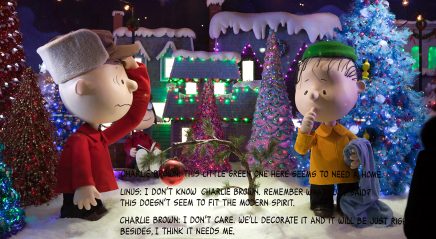The transfiguration is one of my favorite magical Bible stories. It makes me think of some of the best Disney transformation moments. I can just see that bright shining face, that dazzling white robe and Jesus floating above the mountain with Ariel singing of that moment she got her legs. Or maybe it was more of a whirlwind and whoosh a la Cinderella, with a bibbidi-bobbidi-boo.
However it happened, whatever the specifics, it must have been spectacular. Let’s think about the scene. Jesus and the disciples have been traveling for quite some time. They don’t have a change of clothes with them, just what they are wearing, because they have been relying on the kindness of strangers for shelter and provisions, and there are no such things as showers or running water.
So Jesus probably stank. He had melanin-rich skin, darkened from the sun; well-worn clothes, their hems tattered; dark woolly curls; and a matted beard. That’s the image of Jesus I have.
But this isn’t the image I remember from childhood. The image I had of Jesus 25 years ago was a print by Warner Sallman called “He Careth for You.” If I remember correctly, this artwork hung in the women’s bathroom of my childhood Lutheran church.
In the background of the print are a church spire and a house, in the middle ground a large flower bush with white blossoms, and in the foreground, with Jesus, three children and a lamb. On the right a boy cups a bird in his hands, and on the left the smaller of the two girls stares intently at Jesus, who looks off into the distance. His expression and pose are identical to those in Sallman’s more famous work, “Head of Christ,” which pictures Jesus in a white robe, with bright eyes, tanned skin and shiny blond hair with a hint of curl.
I never understood that “art.” As a kid, I wondered why the boy was giving Jesus a bird. As a tween, I wondered who did his hair. And in high school I began to wonder why Jesus was white.
Melanin-rich skin, darkened from the sun; well-worn clothes, their hems tattered; dark woolly curls; and a matted beard. That’s the image of Jesus I have.
Beloveds, I’m convinced the transfiguration story is where we get white Jesus (Matthew 17:1-8). I’m convinced that this change, this shift, this transformation of Jesus was a turning point and a signal for later audiences of this Gospel to see Jesus transfiguring into whiteness. Over time, that whiteness prevailed for some beyond all logic and reason, but I guess that’s how racism works—beyond all logic and reason.
Beyond all logic and reason feels like a familiar refrain for me as a Black woman. Every day something happens in the life of a Black person that is beyond all logic and reason.
We need legislation to ensure job security if our hair is natural. Beyond all logic and reason.
Trayvon Martin was killed for buying Skittles and an Arizona Watermelon drink. Beyond all logic and reason.
Police openly murder Black people and get acquitted. Beyond all logic and reason.
Black people are treated as if they are worthless, expendable, ignorant beasts. If we do escape this image, we are reminded that our blackness must be suppressed if we want to survive and thrive in a white world.
As a Black pastor in the United States’ whitest denomination, I’ve faced this head-on. My blackness is inextricably bound to my femaleness, my cisgenderness, my queerness, my disabledness, my fatness—but my blackness is seen first and is the context by which I am misjudged and mistreated.
Just as easily as Jesus walks up a mountain and transforms from a filthy yet charismatic former-carpenter-turned-quixotic-enigmatic-Black-nomad into a fresh-faced white God, sporting a sculpted brow, luscious shiny hair, a perfectly shaped and conditioned beard, and the crispest winter white robe, are we supposed to let go of the cultural richness embedded in our souls from our African ancestors? Are we supposed to shake off the trauma written on our DNA from 400 years of enslavement? Are we supposed to transfigure into the dominant culture?
Now is the perfect time for all of us, regardless of race, to embark on transformation that fulfills our baptismal call and follows the examples set forth by Christ.
No, beloveds. This hipster Jesus isn’t real. Just as Cinderella’s carriage turned back into a pumpkin, Jesus got a white robe but his skin stayed black.
Jesus transfigured for Peter, James and John, but when the cloud and Moses and Elijah disappeared, so did the glitz and glamour. That transfiguration, that metamorphosis, confirmed for these three beloved disciples that they were in the presence of the Divine One.
Moments of metamorphosis are not just for Christ. We can all experience times of change and transformation, ordinary and extraordinary. Now is the perfect time for all of us, regardless of race, to embark on transformation that fulfills our baptismal call and follows the examples set forth by Christ. Most importantly, though, especially for Black people, Indigenous people and other people of color, I hope that any change is authentic and embodied, and that we never surrender the core of who we are or the values that created and prepared us for the mystical change we are undergoing.
We are called to celebrate our Black and Brown bodies wholly. We are made by God, in the image of God, so we must be good.
As I ponder this text, I keep coming back to that line in Sam Cooke’s “A Change Is Gonna Come”: “It’s been too hard living, but I’m afraid to die.” I can’t help thinking of all the lives lost to violence. It’s infuriating how pertinent this song is nearly 60 years later, but I believe the words are true.
In the words of Langston Hughes, from his 1951 poem “Necessity”: “I don’t have to do nothing but eat, drink, stay black, and die.”
Thanks be to God.








